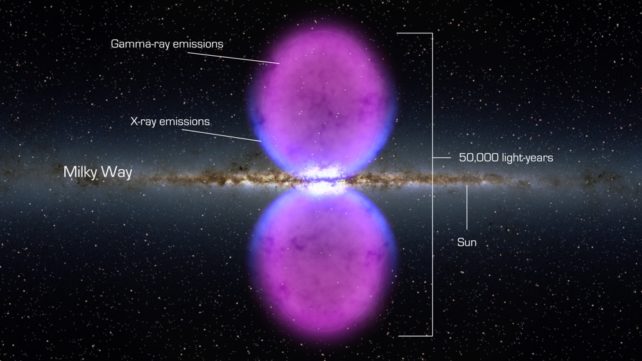A gamma-ray trickster has just been found in the vicinity of the Milky Way.
Energetic radiation previously associated with structures erupting from the Milky Way galactic center called the Fermi bubbles actually seems to instead be coming from something more distant.
The origins are instead thought to be millisecond pulsars in a small dwarf galaxy orbiting our own.
The discovery has implications for our understanding of the Fermi bubbles, but it also could have an impact on broader areas of research, such as the search for galactic dark matter.
The Fermi bubbles were discovered in 2010, and were a huge surprise, quite literally. They are gargantuan bubbles of high-energy gas emanating from the galactic center that extend above and below the galactic plane, for a total distance of 50,000 light-years, expanding at a rate of millions of miles an hour.

Whatever created them – the Milky Way's supermassive black hole being a leading candidate – did so millions of years ago, and the bubbles have been blowing upwards and outwards ever since. They're brighter in high-energy gamma radiation than the rest of the Milky Way's disk.
Not all the radiation from the Fermi bubbles is evenly distributed. In particular, there is what is described as a "cocoon" of freshly accelerated cosmic rays in the southern lobe, interpreted on its discovery in 2011 as part of the superbubble environment.
Now, a team of astronomers, led by astrophysicist Roland Crocker of the Australian National University in Australia, has noticed something interesting.
The location of the cocoon is directly coincident with the location of another object – the core of Sagittarius dwarf spheroidal galaxy, a satellite of the Milky Way that is in the process of being torn apart and subsumed by the larger galaxy.
This, on its own, would be a pretty big co-inky-dink, with a very low probability of around 1 percent. But it gets even more interesting. The cocoon and the Sagittarius galaxy also have similar shapes and orientations.
Of course, distance in space can be extremely hard to gauge. Unless you know precisely how much light something is emitting, it's hard to know how far away it is.
If you see something emitting gamma radiation in a larger gamma radiation structure, it's probably natural to assume that the two are related. But two things with similar shape and orientations lining up directly in our line of sight would be, well, really peculiar.
Not impossible, but there might be a more likely explanation – such as a link between those two objects.
So the researchers decided to revisit the cocoon, and see if the dwarf galaxy could possibly be an alternative explanation for the gamma radiation observed therein.
They modeled the emission over a range of explanations, including the intra-bubble cocoon and the Sagittarius galaxy, and found that, by quite some significance, the Sagittarius galaxy was the most likely emitter of the gamma radiation in the Fermi cocoon.
The next question, naturally, was what could be producing it. In the Milky Way, gamma rays are predominantly generated by collisions between cosmic rays and the gas in the interstellar medium.
This is not possible for the Sagittarius galaxy. The smaller satellite galaxy is gravitationally falling into the Milky Way, and has been for some time; as such its gas has been neatly stripped away, probably around 2 to 3 billion years ago.
Nor have any massive, short-lived stars been dying in spectacular supernovae; these are born from gas, and, well. There is none.
The most likely explanation, the team found, is millisecond pulsars. These are neutron stars (the collapsed, ultra-dense cores of dead massive stars) with extremely fast spin rates, on millisecond scales; as they spin, they emit jets of radiation from their poles – including gamma radiation.
These would be compatible with the most recent episodes of star formation in the Sagittarius galaxy, and have the same spatial distribution as the rest of the stellar population.
Although the gamma radiation seems bright compared to other galaxies such as Andromeda, this would be possible if the pulsars were 7 to 8 billion years old, and low in metal content – consistent with the rest of the Sagittarius population, the researchers say.
This finding suggests that dwarf spheroidal galaxies like Sagittarius might produce more gamma radiation than expected.
If so, they could confound searches for dark matter signals, one of which is hypothesized to be an excess of gamma radiation emitted as dark matter particles and antiparticles mutually annihilate each other.
The possibility, the researchers say, should prompt a closer look at these small, faint galaxies, to see if we need to revise our understanding of dwarf spheroidal galaxies, and the old populations of stars they contain.
The research has been published in Nature Astronomy.
